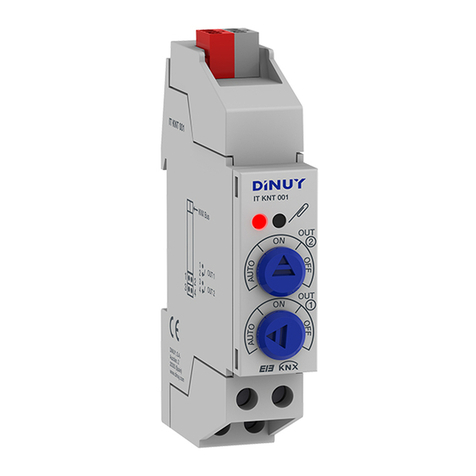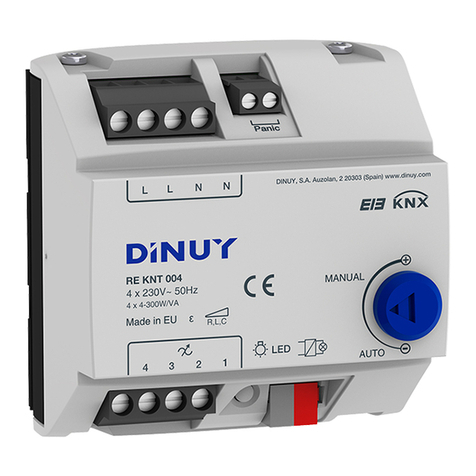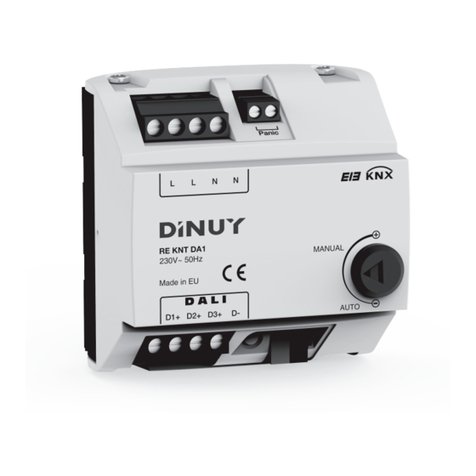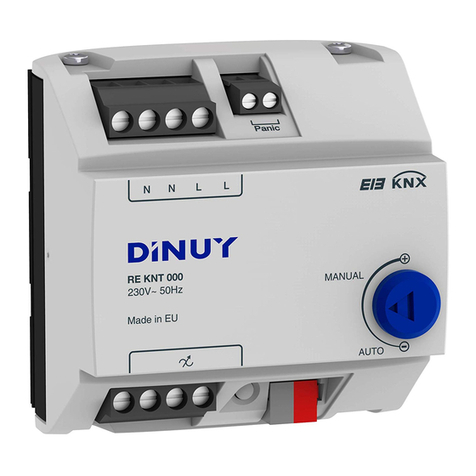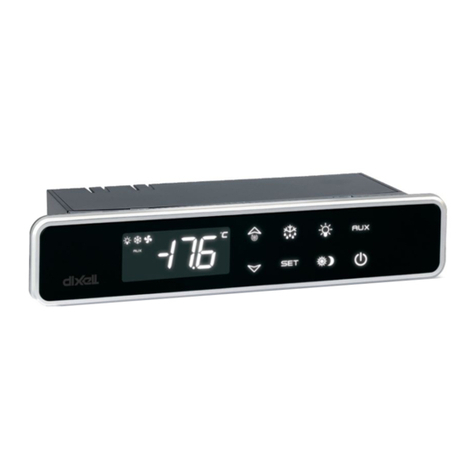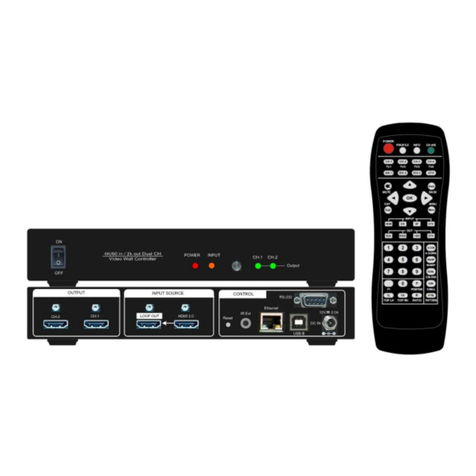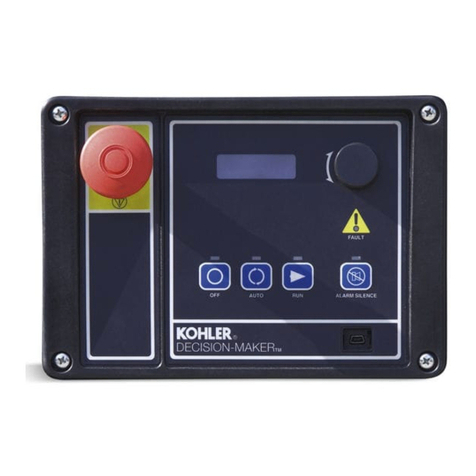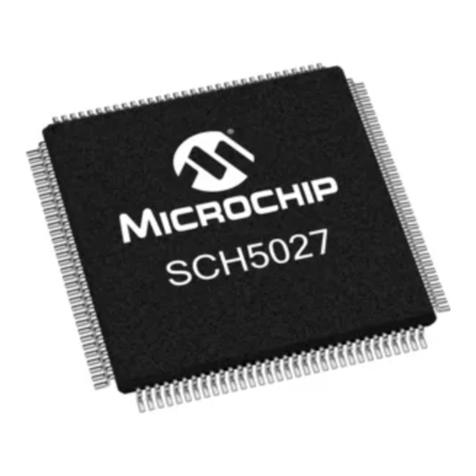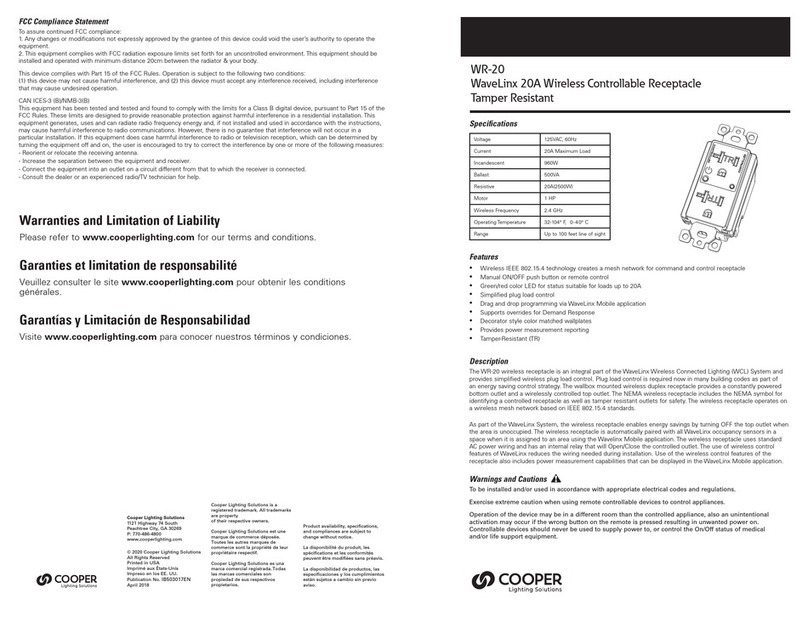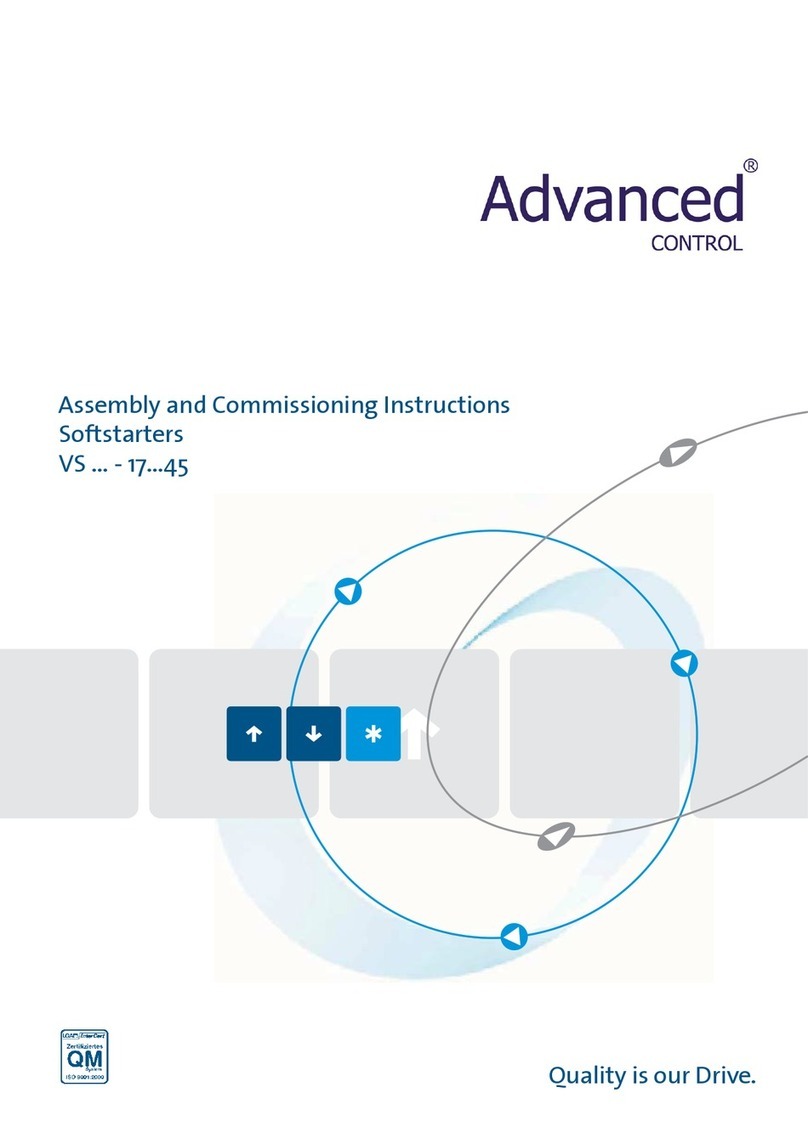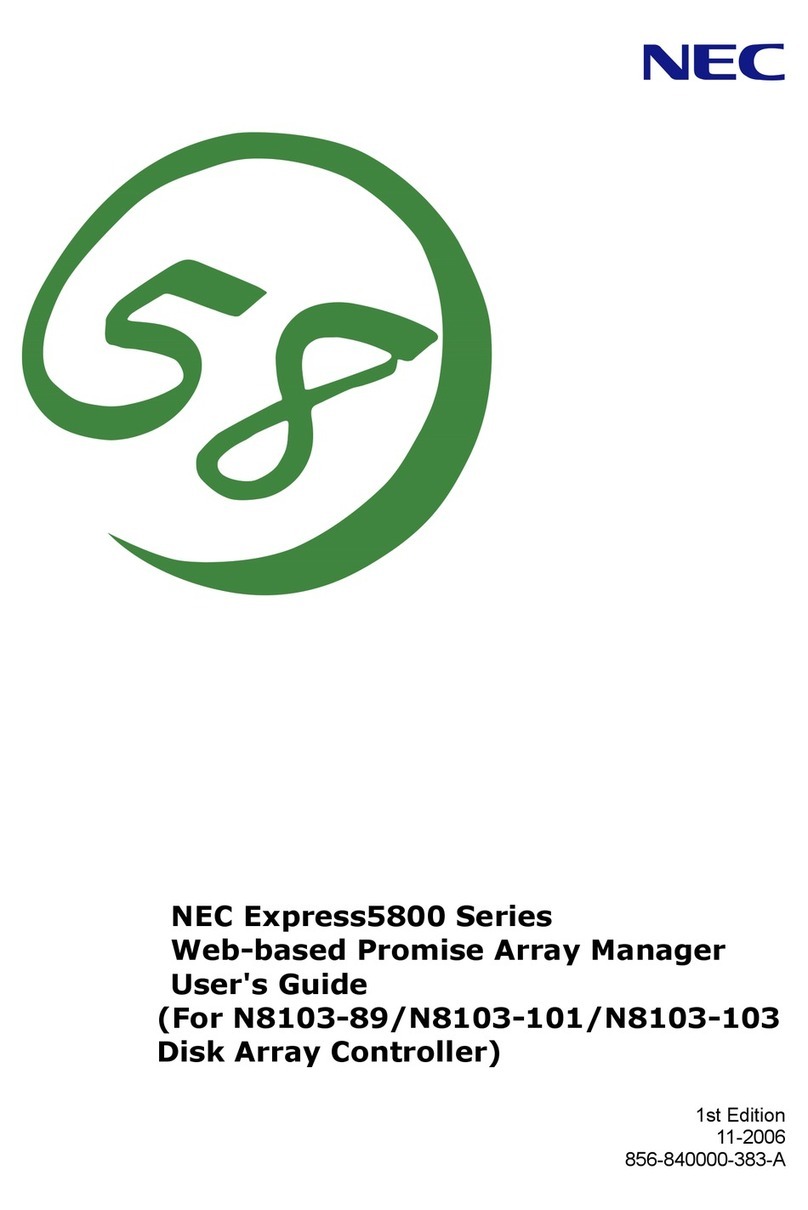DINUY KNX RE KNT 008 User manual

EGB
ACTUADOR DE REGULACIÓN UNIVERSALRLC+LED DE 8 CANALES
ESPECIFICACIONES TÉCNICAS
DESCRIPCIÓN
Actuador de regulación modular universal, de 8 canales de salida independientes, por control de fase
(principio o fin de fase), siendo válido para diferentes tipos de carga RLC + LED:
· Lámparas LED 230V~ regulables.
· Lámparas LED 12V~ regulables con transformador electrónico.
· Incandescencia y Halógenas 230V.
· Halógenas con transformador electrónico.
Dispone de los siguientes elementos:
· A: Terminal KNX
· B: Botón y LED de Programación
· C: Alimentación de red
· D: Alimentación de cada canal
· E: Canales de salida
· F: Teclas de control manual
· G: LEDs para indicar el modo del teclado (Bus KNX o Manual)
· H: LEDs de alarmas
Protegido frente a sobrecargas y cortocircuitos. Protección térmica de funcionamiento rearmable.
Unidad de Acoplamiento al BUS (BCU) integrada.
Montaje en carril DIN.
Programación y puesta en marcha mediante ETS5 o versiones posteriores.
Tensión Nominal 230V~ 50Hz
Consumo de la red < 1,5W
Alimentación desde KNX 21 ~ 32Vcc (a través del Bus)
Consumo del Bus < 3mA
Conexión al Bus KNX Mediante terminal de conexión
Programación a través de ETS5 o posterior
Medio KNX PT1
Canales de Salida 8
Puesta en Marcha System Mode
Montaje Carril DIN 46277
Temperatura almacenamiento -30ºC ~ +70ºC
Grado protección IP20 (EN60529)
De acuerdo a las Directivas Seguridad 73/23/EEC
Comp. Electromagn. 204/108/EC
Certificación EIB/KNX
Tensión Aislamiento 4KVCA (tensión alimentación/bus)
Carga
Incandescencia
Halógenas 230V
Halógenas con trafo Electrónico
Lámparas LED 230V~ (regulables a principio de fase)
Lámparas LED 230V~ (regulables a fin de fase)
Lámparas LED 12V~ (con trafo Electrónico)
4 ~ 300W por canal
4 ~ 300W por canal
20 ~ 280VA por canal
4 ~ 120VA por canal
4 ~ 250VA por canal
10 ~ 280VA / canal de transformador
Dimensiones 8 módulos, 140 x 65 x 90 mm
Temperatura funcionamiento -5ºC ~ +45ºC
De acuerdo a las Normas KNX Standard 2.0
EN60669-1, 2-1 y 2-3
ATENCIÓN: ¡Tensión peligrosa!.
¡Los trabajos con equipos eléctricos en la red de 230V, deben de ser realizados
exclusivamente por técnicos cualificados!.
¡Desconecte la tensión de red antes de proceder al montaje, desmontaje o manipulación del
equipo eléctrico!.
8-CHANNEL UNIVERSAL RLC+LED DIMMING ACTUATOR
TECHNICAL DATA
Nominal voltage 230V~ 50Hz
Consumption from Mains < 1,5W
Supply from KNX bus 21 ~ 32VDC (via Bus)
Consumption from KNX bus < 3mA
Connection Connecting terminal
Commissioning ETS5 or later
KNX Media TP1
Channels 8
Configuration mode System Mode
Insulation voltage 4KVAC (bus/mains voltage)
Load
Incandescence
Halogens 230V
Halogen with Electronic transformer
230V~ LED Lamps (dimmable by leading-edge)
230V~ LED Lamps (dimmable by trailing-edge)
12V~ LED Lamps (with Electronic transformer)
4 ~ 300W per channel
4 ~ 300W per channel
20 ~ 280VA per channel
4 ~ 120VA per channel
4 ~ 250VA per channel
10 ~ 280VA of transformer per channel
Mounting DIN 46277 rail
Storage temperature -30ºC ~ +70ºC
Protection degree IP20 (EN60529)
Directives Low-voltage 73/23/EEC
EMC 204/108/EC
Marking EIB/KNX
Dimensions 8 modules, 140 x 65 x 90 mm
Working temperature -5ºC ~ +45ºC
According to the Standards KNX 2.0
EN60669-1, 2-1 & 2-3
WARNING: Hazardous voltage!.
Work with electrical equipment on the 230V mains must be carried out only by qualified
technicians!.
Switch off the mains before installing, removing or handling of electrical equipment!.
DESCRIPTION
8-channel universal modular dimming actuator for leading and trailing edge phase control (R, L, C and
LED loads):
- Dimmable 230V~ LED lamps.
- Dimmable 12V~ LED lamps with electronic transformer.
- Incandescence & Halogens 230V~.
- Halogens with electronic transformer.
It has the following parts:
· A: KNX terminal
· B: Programming LED and button
· C: Main supply
· D: Supply of each channel
· E: Output channels
· F: Buttons for manual control
· G: LEDs to indicate the keyboard mode (KNX Bus or Manual Control)
· H: Alarm LEDs
Protected against overloads and short-circuits. Built-in resettable heating protection.
Incorporates the Bus Coupling Unit (BCU).
DIN-rail mounting.
Programmation and commissioning by ETS5 or later.
RE KNT 008
A
C
D
E
F
B
H
G
Fig. 1

DINUY S.A.
c/Auzolan Nº2
20303 Irún (Spain)
Tel.: +34 943 62 79 88
E-mail: knx@dinuy.com
Web: www.dinuy.com
GB E
MANUAL CONTROL
The Actuator has a keypad on the front, which allows a manual control of each channel independently.
To carry out the manual control, it is simply necessary to keep the and keys of the channel to
be controlled pressed at the same time.
Once the channel is in Manual mode, the white LED corresponding to its channel (G) will turn on. If it is
in Timed Manual mode, the white LED will flash.
When a 230V reset is done, 2 situations may happen:
· The Actuator has never been programmed with the ETS: all 8 channels enter into Manual mode.
· The Actuator has been programmed by ETS previously: each channel will enter into the preset mode
in ETS.
If the Actuator is configured as a “Sequencer” through the ETS, the buttons will not perform any
function.
If a Channel is configured as Manual from ETS, it is not allowed to switch to KNX Bus mode by
pressing the ON and OFF keys at the same time.
INSTALLATION AND WIRING
Follow the next steps for installation (Fig. 2):
1) Connect the KNX bus to the connecting terminal (A).
2) Install the lamps to the dimmer.
3) Switch-on the mains supply.
4) Switch-on the bus supply.
COMMISSIONING
1) Press the programming key (B). The programming LED lights up red.
2) Program the physical address and application into the dimmer with the ETS.
3) The programming LED goes out: the application has been loaded successfully and the dimmer is
ready for working.
PROGRAMMING KEYAND LED (B)
In addition to enabling putting the actuator into operation, it is also useful to inform about a blocking
problem of the dimmer, lighting alternately in red and green.
This can only be due to incorrect programming from ETS.
In case of this problem, it would be necessary to reset the device, which consists of removing the
terminal (A) from the KNX bus, waiting a couple of seconds and reconnecting the KNX terminal (A)
while the programming key (B) is being pressed. Moreover, after this step, it should be reprogrammed
by the ETS.
Furthermore, the green LED flashes for a few seconds after a starting, during the initial process of
setting parameters.
ALARMAS
The Actuator has 2 error LEDs:
· 230V~ : switched-on in green indicates that the dimmer is powered correctly. The flashing indicates
that an overload has previously occurred in some output channel.
· : switched permanently on in red indicates an over-temperature in the dimmer. The falshing
indicates that an over-temperature has previously occurred.
CAUTIONS AND LIMITATIONS
· The mains supply must be protected according to existing rules.
· The devices must be installed without power supply and by qualified personnel.
· Do not apply power if the dimmer is without load.
· The first time the Actuator is powered, without having been previously programmed, it is done with
“trailing edge phase control” dimming technology. Make sure that the connected lamps support this
type of dimming if you connect them before programming the device.
· Disconnect the mains to handle the load, replacing burned-out lightbulbs, removing or adding new
ones.
· Do not exceed the maximum load of the device.
· Do not connect different channels to increase the power capacity.
· Do not mix different types of load (capacitive / inductive) on the same channel.
· It is not recommended to connect different models of LED lamps on the same channel.
· Do not install dimmers next to each other. Leave free at least one module gap between them or other
sources of heat.
· Design the installation cabinet properly to avoid heat problems. In some cases may require forced
ventilation.
· The device may block if the overload, short-circuit or thermal protection are activated. Disconnect the
electrical supply, correct the fault and restore the supply in order that the device returns to be
operative.
Fig. 2
-
+Bus KNX
C1
C2
C3
C4
C5
C6
C7
C8
L
N
CONTROL MANUAL
El Actuador dispone de una botonera en el frontal, la cual permite un control manual de cada uno de
los canales, de forma independiente.
Para ello, simplemente es necesario mantener pulsadas, al mismo tiempo, las teclas y del
canal que se desee controlar.
Una vez que el canal se encuentre en Modo Manual, el LED blanco correspondiente a su canal (G) se
encenderá. Si se encuentra en modo Manual Temporizado, el LED blanco parpadeará.
En el momento que se realiza un reset de los 230V, pueden darse 2 situaciones:
· El regulador nunca ha sido programado con el ETS: los 8 canales entran en modo manual.
· El regulador dispone en memoria una programación ETS: cada canal entrará en el modo predefinido
en ETS.
Si el Actuador está configurado como “Secuenciador” a través del ETS, los pulsadores no realizarán
ninguna función.
Si un Canal se configura como Manual desde ETS, no se permite pasar a modo Bus KNX pulsando al
mismo tiempo las teclas ON y OFF.
INSTALACIÓN Y CABLEADO
Siga los siguientes pasos para su instalación (Fig. 2):
1) Conecte el Bus KNX al terminal de conexión (A).
2) Conecte las lámparas al regulador.
3) Active la alimentación de red.
4) Active la alimentación del Bus KNX.
PUESTA EN MARCHA
1) Presione la tecla de programación (B). El LED de programación se ilumina de forma permanente en
rojo.
2) Programe la dirección física y la aplicación en el regulador desde el ETS.
3) El LED de programación se apaga, indicando que la programación se ha realizado correctamente y
el actuador está listo para funcionar.
TECLA Y LED DE PROGRAMACIÓN (B)
Además de posibilitar la puesta en marcha del dispositivo, permite informar de un problema de bloqueo
del regulador, parpadeando lentamente en rojo y verde.
Esto sólo puede ser debido a una programación incorrecta desde el ETS.
En caso de darse esta situación, sería necesario Resetear el dispositivo,que consiste en sacar la ficha
del bus KNX (A), esperar un par de segundos y volver a conectar la ficha KNX (A) mientras se tiene
pulsada la tecla de programación (B). Además, tras este paso, habría que volver a programarlo
mediante el ETS.
Por otra parte, el LED verde parpadeará durante unos segundos después de un arranque, mientras
dura el proceso inicial de configuración de parámetros.
ALARMAS
El Actuador dispone de 2 LEDs indicadores de error:
· 230V~ : encendido en verde de forma permanente indica que el regulador esta alimentado
correctamente. La intermitencia indica que anteriormente se ha producido una sobrecarga
en algún canal de salida.
· : encendido en rojo de forma permanente indica sobre-temperatura del regulador. La
intermitencia indica que anteriormente ha sucedido una sobre-temperatura.
PRECAUCIONES Y LIMITACIONES
· El suministro de red debe estar protegido de acuerdo a las normas vigentes.
· Los dispositivos deben ser instalados en ausencia de red y por personal cualificado.
· No conecte el suministro eléctrico si el regulador se encuentra en ausencia de carga (en vacío).
· La primera vez que se alimenta el Actuador, sin haber sido programado previamente, lo hace con
tecnología de regulación “a final de fase”. Asegúrese que las lámparas conectadas admiten este tipo
de regulación si las conecta antes de programar el dispositivo.
· Desconecte la tensión de red para manipular la carga, al sustituir lámparas fundidas o al quitarlas o
añadirlas.
· No exceda la carga máxima del aparato.
· No conecte entre sí diferentes canales para aumentar potencia.
· No mezcle distintos tipos de carga (capacitiva/inductiva) en el mismo canal.
· No es recomendable conectar diferentes modelos de lámparas LED en el mismo canal.
· No instale los reguladores unos junto a los otros. Deje libre, al menos, un módulo de distancia a los
lados del regulador.
· Dimensione adecuadamente el armario para evitar problemas térmicos. En algunos casos se podrá
requerir ventilación forzada.
· El aparato puede bloquearse si actúan las protecciones de sobrecarga, cortocircuito o térmica.
Desconecte el suministro eléctrico, subsane la deficiencia y restablezca la red para que el aparato
vuelva a ser operativo.
OFF/ON/
OFF/ON/
Other DINUY Controllers manuals
Popular Controllers manuals by other brands
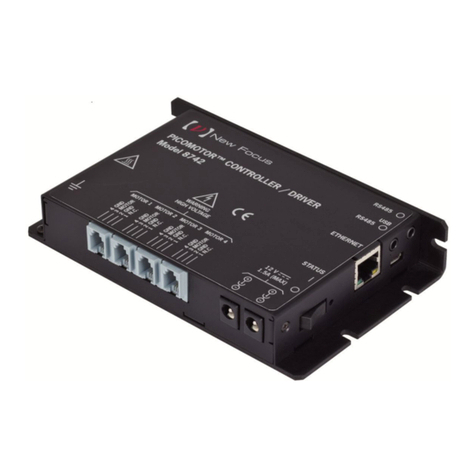
Newport
Newport New Focus Picomotor 8742 user manual
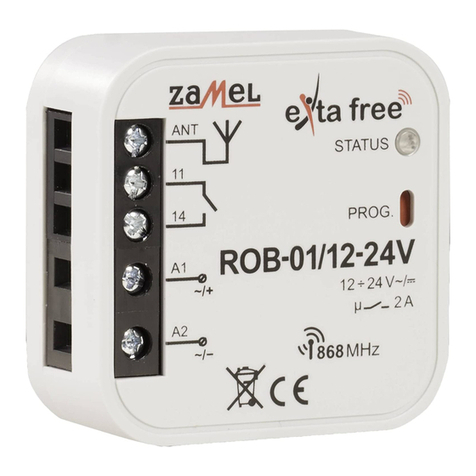
Zamel
Zamel ROB-01 manual
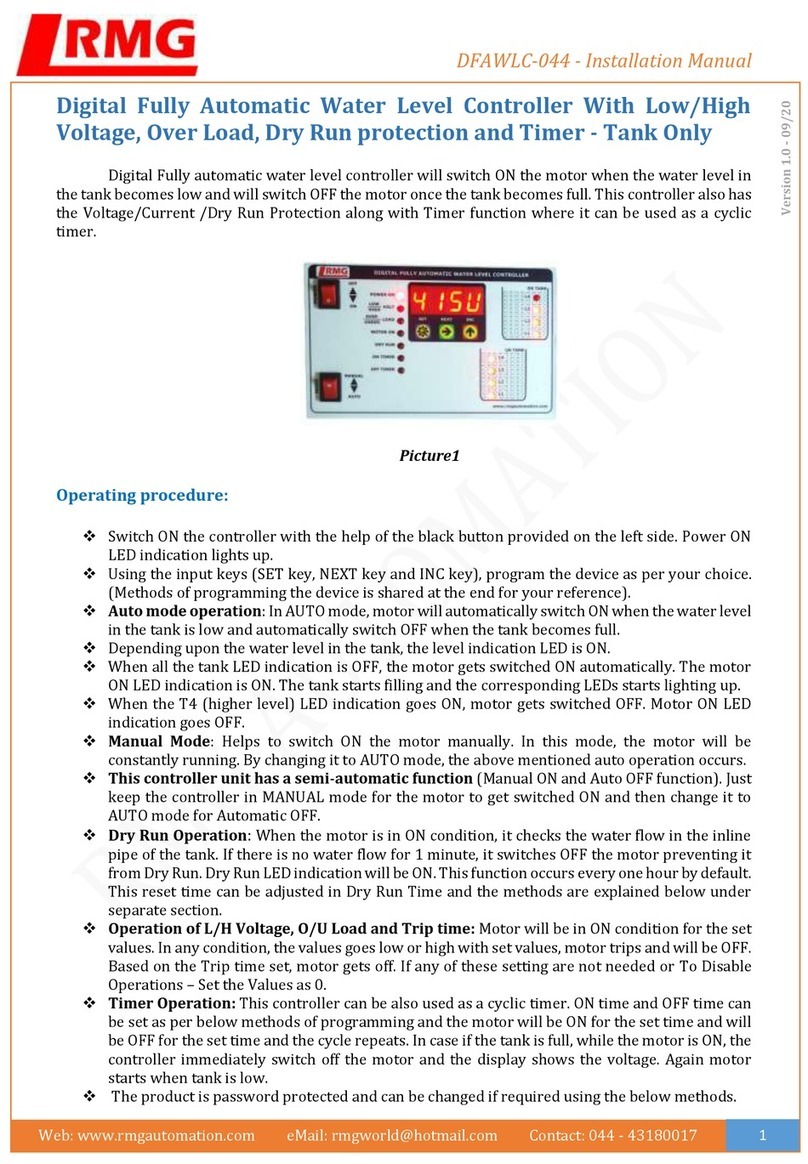
RMG
RMG DFAWLC-044 installation manual
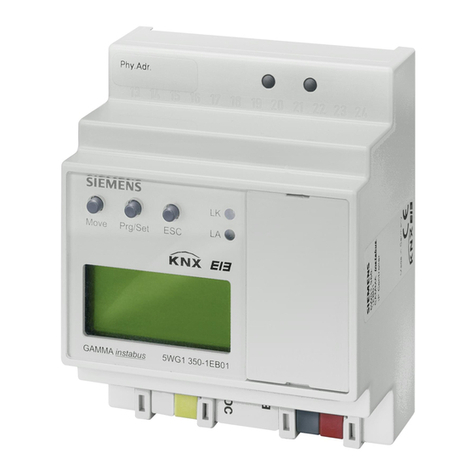
Siemens
Siemens IP Controller N350E Technical product information

Honeywell
Honeywell Aquasat L7224 A Aquasat L7224 C manual
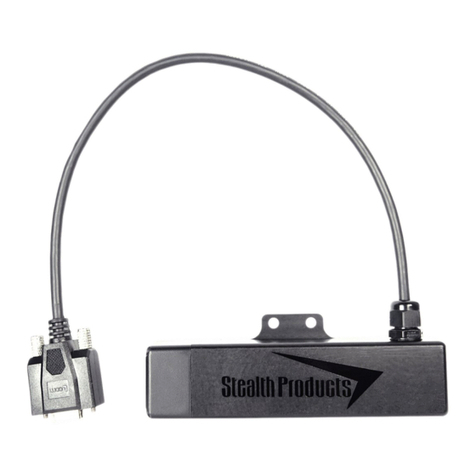
Stealth Products
Stealth Products i-Drive 4.0 User's manual and maintenance guide
